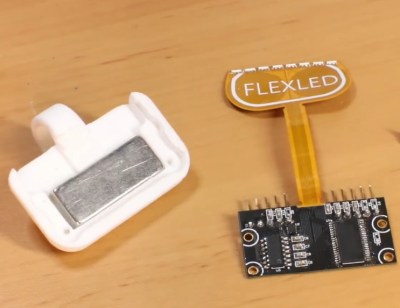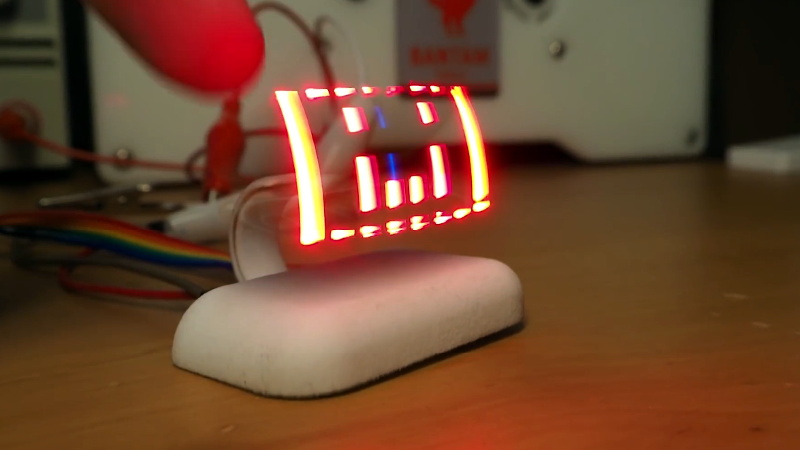With his FlexLED project, [Carl Bugeja] is trying to perfect a simple and affordable persistence of vision (POV) display capable of generating “holographic” characters in mid-air. Traditionally POV systems spin LEDs rapidly to create the desired illusion, but that means motors, slip rings, and noise. As the name implies, the goal with this project is to do away with all that and replace it with a self-actuating flexible PCB.
 The device is able to quickly move the LEDs back and forth quietly and efficiently thanks to a permanent magnet and magnetic coils integrated into the flexible PCB. With no motors or gears, the whole unit is smaller and less complex than other POV displays. As an added bonus, there’s no danger to the operator or the device should a curious user stick their finger into it.
The device is able to quickly move the LEDs back and forth quietly and efficiently thanks to a permanent magnet and magnetic coils integrated into the flexible PCB. With no motors or gears, the whole unit is smaller and less complex than other POV displays. As an added bonus, there’s no danger to the operator or the device should a curious user stick their finger into it.
The last time we took a look at this project, [Carl] had entered an earlier single-LED version into the 2019 Hackaday Prize. Competition was tough last year, and unfortunately FlexLED didn’t get selected as a Finalist. But we’re still extremely interested in seeing the project develop, and we imagine so are you.
The recently completed second version of the display features an improved coil design, eight RGB LEDs and a 3D printed base with integrated magnet. With more LEDs onboard, a single display is able to show multiple characters and even rudimentary animations. A large array of these flapping elements promises to be quite a sight.
But before you get too excited, [Carl] does have some bad news. For one, the cost of building them in small quantities is high, which is always tough for a single hacker trying to iterate a design. Worse, some of the LEDs seem to have died on this prototype already. He says it likely has something to do with the stress of flexing back and forth so quickly, which is obviously a bit troubling. He’s looking to get some feedback from the community, and is hoping to address these issues in the next version.
For an interesting look into his flexible PCB actuator projects, check out the interview [Carl] did with us at the 2018 Hackaday Superconference.
















Strain reliefs and braided lines (like audio drivers) But, alas, the mass goes up rapidly.
It reminds me of the vibrating optical fiber heads-up display from Bell Helicopter almost 40 years ago, described here: http://wearcam.org/computing/HUD-paper/HUD.html (see Fig. 4).
That would be one way to increase the resolution somewhat
The Nintendo Virtual Boy used a linear array of LEDs and a vibrating mirror to do the same thing.
That’s right, almost 15 years later… And a decade after Reflection Technologies did the exact same mirror trick in their “Private Eye” HUD, which is what I presume Nintendo either licensed or stole outright.
If add a light tiny OLED display without PCB and controller IC to this device it will be a 3D display?
Neat Idea. Tek (I think) had a demo of something similar: An oscilloscope display reflected in a vibrating mirror: the moving mirror moved the (virtual) image to make the 3D image at something like 30 Hz, requiring a frame rate on the display device of a few thousand frames/second.
For a “minimum viable display” we could ask a 64×48 OLED to do this and produce a cuboidal volume 64x48x (say) 50 slices, and we’d want it to vibrate at at least 10 Hz to produce 20 volumes/second, requiring 1000 frames/sec, or 3 million pixels/second.
Maybe too much for the I2C data transport, but trivial for a parallel datapath, and even do-able with SPI: The usual SSD1306 controller used on these little OLEDs can clock in SPI at 10MHz. However, the stock frame rate is only 120 Hz.